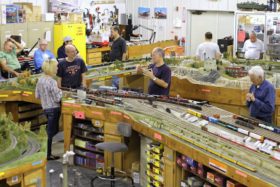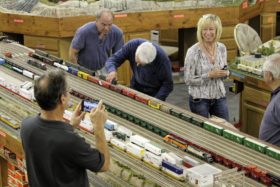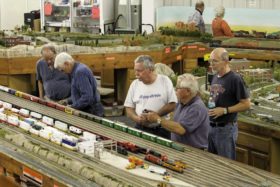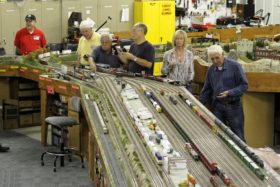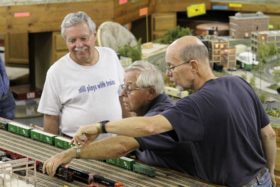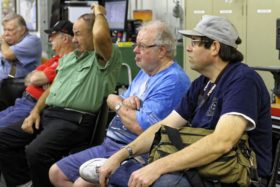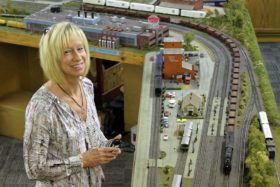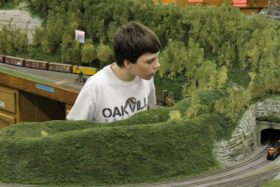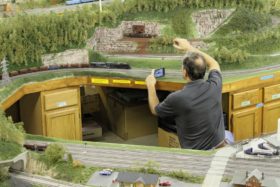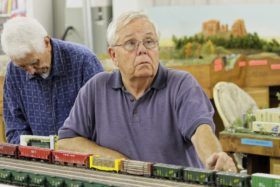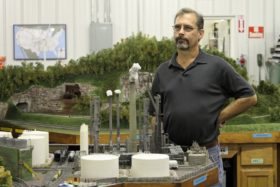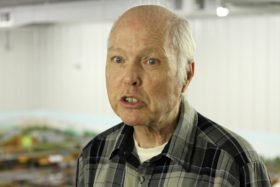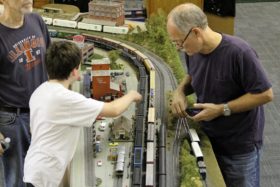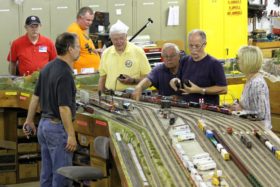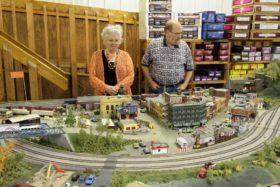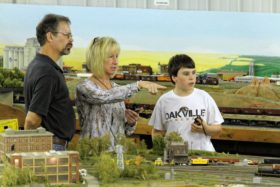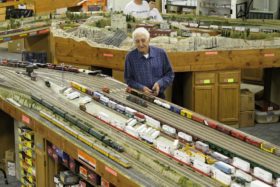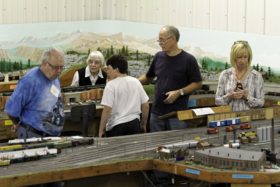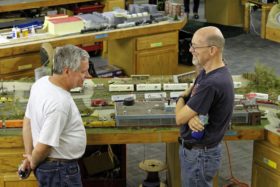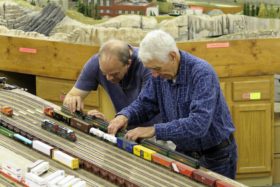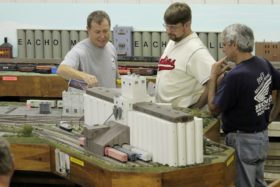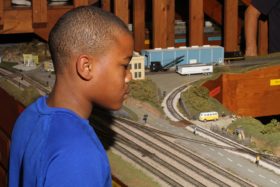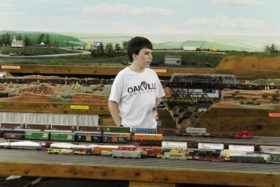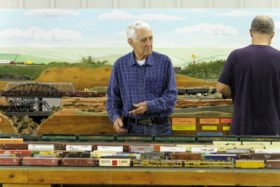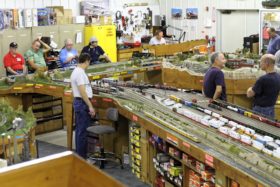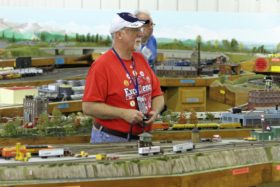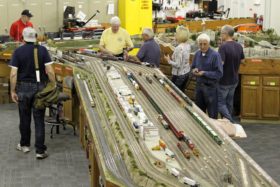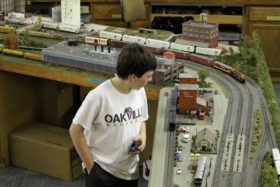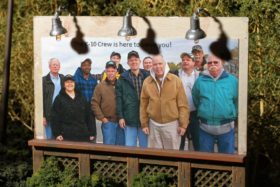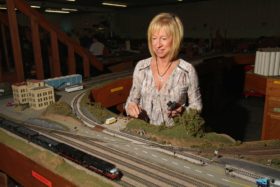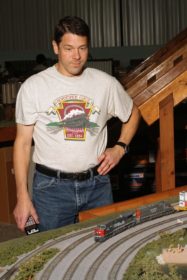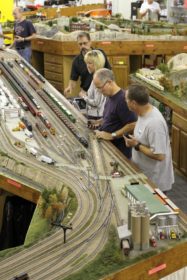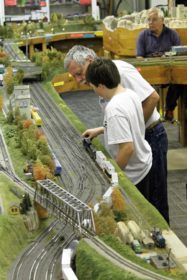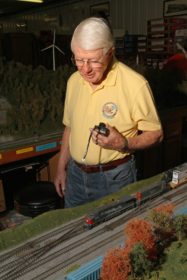Photos by Richard Schumacher
The advertising was not wrong. WOW! What a great time, what a great pike! Thanks to Ron Gawedzinski for setting up this event and Ken Kroschwitz of K-10 Hobbies and his minions (minions is meant in the spirit of fun loving assistants consistent with the fun loving minions found in animated movies) who were gracious hosts and literally gave us the run of the railroad. Between the two groups we made a showing in the 20 person range.
Upon arrival the K-10 docents set us up with trains from one of the three major freight yards or made provisions for foreign road run throughs of visitor supplied equipment. While a passenger station does in fact exist, apparently varnish is not an often seen commodity on this layout. Perhaps that is why the station is relegated to a back corner. I used the term docent on purpose because they acted in that manner by providing us with answers to questions and assistance if asked, but other than that leaving us to our own devices to enjoy the layout.
When the operating session was getting underway Ken made a short announcement to the group with some interesting facts and updates about the layout. For the ancient history of this almost 20 year old empire you can visit the K-10 website at http://www.k-10smodeltrains.com/ and click on the history tab. The most recent changes he described are the changeover of the “High Line” from DC to DCC, the consolidation of several of the intermodal yards to one, the addition of a new industrial switching district on the old intermodal peninsula and some foreshadowing of a few more ideas not quite as of yet fully baked. He also let us know that there is over a true mile of track, almost 500 turnouts, and approximately 1,100 feet of mainline to traverse when circumnavigating the layout four times before you retrace your tracks, literally.
The layout, as designed and built was set up with two separate loops, a High Line and Low Line, each circling the layout twice. The High Line was DC to accommodate those customers of the Hobby Shop who wanted to test their new DC engines and the Low Line to do the same for DCC equipment. Ken explained that since the building of the layout, which started in 1998, most equipment is now DCC and sound equipped. So, I guess like many prototype railroads he must have come to the conclusion that he needed to evolve with the times or be left behind. Therefore, earlier this year he made the decision to switch the High Line over to DCC. In talking with the Tony Pellegrino, who is a part of the crew working on this DC to DCC conversion project he indicated it went relatively smoothly. They simply removed the DC power supplies and reconnected the power existing power busses directly to the DCC system. After that there were a couple of big steps and then some mopping up. The big steps consist of going back through the layout to upgrade the feeder connections from the rails to the busses with new feeders to insure reliability. And they are in the process of adding new power feeders to all the yard tracks from the former High Line (ATSF) yard to convert it over from power routing via turnouts to continuous power. He also said that at all the existing turnouts they are cutting gaps into the rails to isolate the frogs. These items should take care of most of the conversion, but I’m sure there will be a few gremlins that will need to be exercised when these operations are wrapped up. What they thought might take a year is looking more like a 4 month project.
Ken explained that during operations sessions they found that the crews did not embrace the intermodal operations because of the limited switching opportunities. As a result of this, this asset was being underutilized. The decision was made to repurpose that real estate for other more profitable operations. The intermodal island has been cleared and a new industrial district is sprouting up complete with an ethanol facility. One of the other intermodal areas may be in play for a dock facility.
Train running was fantastic as the trains ran flawlessly on great track with consistent power supply through wonderfully sceniced venues. For ease of operation all trains on the road moved in the same direction. What velocity. All we had to do was not run into the train in front of us. We had a steam powered ore train behind Don Ayres’ Santa Fe, several diesel powered mixed freights, an intermodal train, a steam powered Southern passenger train with heavyweight cars, and a Burlington Northern merger period extremely fast freight with a Burlington unit and a Great Northern unit on the head end run by Alex Schumacher while his dad, Richard, recoded all the events in photos. In addition to the operations, this mature layout offers a very high quality level of scenery and a host of structures, cars, figurines and scenes full of great details.
Overall it appeared to be a great success with everyone seeming to really enjoy themselves. This event, Ken willing, should certainly be kept on the list of quality annual events to partake in. For those of you who could not, or chose not, to make it I would strongly recommend attending if the event is repeated again next year.
Oh yeah. Who could forget how convenient it was, if you chose to take a break, to pop into the cozy but nicely stocked hobby shop. I know I brought home more than I took.
Thanks again to Ron Gawedzinski for setting this up and to Ken Kroschwitz and his crew for their hospitality in providing a wonderful afternoon of model railroad operations and fellowship.

